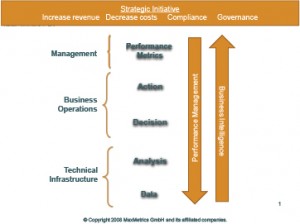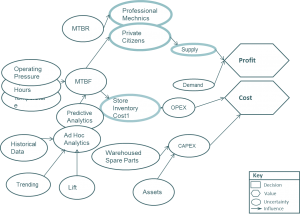In my view, that BI & Analytics contribute to organizational performance with three different levels of importance.
- Tier 1: Business Metrics — Are we contributing to profitable revenue growth?
- Tier 2: User Productivity — Are we impacting the user productivity?
- Tier 3: IT Productivity — Are we more efficient in our IT operations?
In this post, I want to explore the first tier of metrics.
How can BI & Analytics deliver tier one benefits
In this post, I want to expand on the tier one benefits of BI & Analytics. Tier one benefits occur when the application of BI & Analytics are clearly tied to the organization’s core reason for existence. That is, BI & analytics help executives, managers, operational staff, and administrative functions influence profitable revenue growth.
BI & Analytics can contribute to business performance by combining data from different sources and performing different types of analytics to offer intelligence in the decision-making process. There are may different types of BI & analytical technologies such as standard, parameterized, and ad hoc query and reporting solutions; statistical analysis, forecasting, data mining, predictive and descriptive analytics; and, nowadays, social media and visual analytics.
In my opinion, even basic reports can deliver business value. Questions are being posed in innovative ways that look at data in a new light. Data is being combined from sources that have never been joined before. So, a simple list report can trigger new actions that can add value to the business. The strong advantage of advanced analytics is adding precision or predictions. Precision can change the results by as little as few percentage points. But, a few percentage points on millions of dollars can make a big impact. And, predictions allow for preemptive actions to occur.
For example, a simple list of customers that have not used a monthly service for several months can trigger an action to retain the customers. That equals a value-add. However, clustering customers with similar characteristics and predicting customers at risk of becoming non-users is a serious added value.
In my experience, the best way to understand how BI & Analytics can help deliver tier one benefits, is to understand the relationship between the information presented by BI & analytics and how it will be used in the business. The organizational users and operational systems need input that lead to decisions and actions that (dramatically) affect performance metrics. Figure 1 demonstrates the relationship between data and analysis that are used by the business operations to ultimately impact performance.
 Figure 1 Relationship between BI and Analytics and Organizational Performance
Figure 1 Relationship between BI and Analytics and Organizational Performance
Where is BI & Analytics applicable
BI & Analytics is applicable to and can bring benefit to every industry and most functional areas. The key is to focus on delivering solution, reports, data, and analysis that answer business questions that can be acted upon. The following list indicates some areas where BI & analytics can add actionable intelligence.
Sales & Marketing
- Conversion rates
- Cost of customer acquisition
- Marketing campaign effectiveness
- Cross/up selling products
- Customer retention ratios
Human Resources
- Staff retention rates
- Compensation and benefits
Call centers
- Telesales success rates
- Staffing optimization
Financial Management
- Consolidation & reporting
- Budgeting
- Performance monitoring
- Risk Management
- Credit losses
- Loan default rate
- Statutory reporting
Supplier
- Inventory levels
- Lead times
- Supplier quality
Network operations
- Network traffic
Customer support
- Problem prevention
- Resource allocation
Visualizing BI & Analytic opportunities
I find the best method for brainstorming and identifying how to tie BI & analytics to decision-making is to visualize a process through an influence diagram, value stream map, or balanced scorecard strategy map.
- An influence diagram is a graphic of a decision situation that shows the decisions, uncertainties, and objectives, and how they influence each other. An influence diagram is easy to understand and maps the influences on a decision.
Figure 2 Influence Diagram
- A value stream maps an end-to-end delivery process. It is a tool in value stream analysis to identify waste in an organizations process.
Figure 3 Value Stream Diagram
- The strategy map diagrams the cause and effect relationship between (business) objectives. The objectives are grouped into perspectives (e.g. Financial, Customer, Process, and Learning and Development). The strategy map provides clarity on pinpointing where the results from BI & analytics can derive value and understanding the wider organizational implications. Figure 4 is an strategy map.
Figure 4 Balanced scorecard strategy map
All these methods (plus others) can be used to identify how to best integrate BI & analytics into an organizations business and decision-making process.
Automobile parts retailer example
I will use an example to illustrate what I mean. An automobile parts retailer wants to sell as many automobile parts as possible. To do so, they need to locate stores in a geographic area that has automobiles that need to buy parts. That location could be where there are many professional repair shops or where there are makes and models of automobiles that often need repair. The revenue impacting decisions include where to locate new stores and the parts to stock in those stores. The metrics would be inventory turnover, units sold, along with store revenue and margin.
Specific to the automobile parts retailer example, the Vehicle Identification Number (VIN) identifies many attributes of an automobile including the manufacture, model, make and year of automobile. By combining historical parts sales data with VIN data from an official registrar of automobile locations, a parts retailer can perform analytics to answer critical business questions like where to place the store and what to stock.
Decision: Best geographical location for a store
- Intelligence Needed: Where are there many cars that often need repairs?
- Metric: Revenue per store, Same store sales
Decision: Products to stock in the store
- Intelligence Needed: What parts are most often bought and for what model of car?
- Metrics: Inventory turnover, Unit sales
Figure 4 is a strategy map that relates to the example case.
Summary
The main point is that for BI & analytics to benefit profitable revenue growth, its results have to be used to influence decision-making and business actions. Tier one benefits occur when outputs of BI & analytics are integrated into the business process. The results could be integrated into decision-making or into operational systems. Several mapping techniques could be used to visualize where BI & analytics may add value.
In the next post, I will describe tier two benefits of BI & analytics.



One thought on “Business Intelligence & Analytic Tier 1 Business-driven Performance”
Comments are closed.